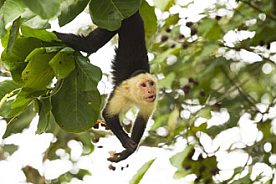Our grading system explained
What makes Costa Rica so special?
Whether you want to spend your time in Costa Rica on hiking trails through ancient forests and thermal hot-spots, discover endless exotic wildlife, soak in hot springs or relax on a pristine beach, our Costa Rica adventure holidays are the perfect way to discover the country’s many natural wonders. You can join one of our small group hiking trips, arrange a private departure on dates to suit you, or let us design the perfect Costa Rica adventure just for you. Contact the office to speak to one of our friendly travel experts and before you know it, you’ll be living the pura vida dream!
Costa Rica Walking Holidays & Tours
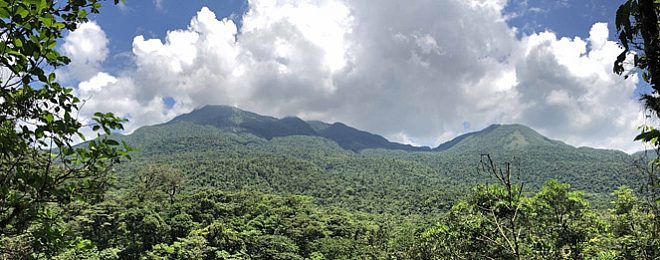
From the coast to mountain, rainforest to river and cloudforest to volcano, Costa Rica's incredible diversity of landscapes supports an abundance of amazing wildlife and makes it one of the world's premium eco-tourism destinations.
Show me:
1 Holiday
- Visit six of Costa Rica’s premier national parks and wildlife reserves
- Enjoy a varied programme of walks that showcase Costa Rica’s incredibly diverse landscapes.
- Spend time in Tortuguero renowned for its fabulous wildlife and laid-back Caribbean vibe.
- Look for rare and exotic birds in the cloudforest of Monteverde and a take a boat tour along the wildlife-rich waters of Caño Negro Reserve.
- Go hiking amidst the surreal and beautiful volcanic scenery of Rincon de la Vieja in the fiery northwest.
- Relax at the end of your holiday on beautiful Hermosa Beach with the option to extend.
Flight inclusive from £5105, Land only from £3895
Gentle Walking & Wildlife Costa Rica
More details- 1
Introduction
Just over twice the size of Wales yet home to approximately 5% of the world’s bio-diversity, Costa Rica packs a powerful eco-punch for a country of its relatively diminutive size. It makes a superb destination for a wildlife-based hiking holiday and our Costa Rica walking holiday is a great introduction to the country and its abundant, diverse wildlife.
Situated between Nicaragua to the north and Panama to the south, and sandwiched between the Pacific and Caribbean oceans, Costa Rica has a vast array of eco-systems. Tropical dry forests, tropical rainforests, mangrove swamps, coastal wetlands, high plateau, mountain ranges, geo-thermal features and cloud forests support a remarkably varied range of flora and fauna. Sloths, toucan, jaguars, resplendent quetzals and giant turtles are the exotic headline attractions but there are myriad mammals, birds, monkeys, butterflies, reptiles and insects to keep even the most hardened wildlife expert interested. In fact, 250 species of mammal, 400 different reptiles and amphibian, 900 species of birds, a quarter of the world’s butterfly population and an incredible 250,000 species of insect, call Costa Rica home. This means that wherever you go you are never far from an amazing wildlife experience.
Costa Rica has four mountain ranges with the highest peak, Chirripό, standing at 3,820m/12,533ft. Two of the mountain ranges are volcanic in origin - the Central Mountains and Cordillera de Guanacaste - part of the Central American Volcanic Arc which stretches for over 900 miles from Guatemala to Panama and has the highest density of volcanoes in the world. Arenal and Rincon de la Vieja are two of the most accessible volcanoes (depending on volcanic activity). There is a network of trails around the volcanic areas linking many amazing thermal features and beautiful thermal pools - giving an extra dimension to any Costa Rica hiking trip.
The country's contrasting coastal regions of are also big draws for visitors and another reason why Costa Rica is an adventure travel mecca. The eastern, Caribbean coast is straight, flat and only 132 miles long whilst the Pacific coast on the west of the country runs for 632 miles has two major peninsulas and numerous islands and inlets. On both sides you can find superb white-sand beaches and warm tropical waters. Tortuguero, on the Caribbean coast is an exception in that it’s not the beaches that attract visitors but turtles as this is one of the most renowned sites for nesting turtles anywhere in the world. Although, even when the turtles aren’t nesting there’s an abundance of other wildlife to discover in this watery haven.
The people of Costa Rica, known as ‘Ticos’, are proud stewards of this rich natural heritage with over a quarter of the country legally protected, including 26 National parks and numerous forest and wildlife reserves. Eco tourism has become an important contributor to economic success in Costa Rica helped by the country’s peaceful outlook, political stability and a strong democratic tradition that sets it apart from its neighbours. Along with its welcoming culture, good quality accommodation and a wide range of exciting outdoor activities to enjoy, Costa Rica is rightly considered one of the world’s prime eco-tourism destinations.
We currently have group departure dates for Costa Rica walking holidays in 2025 and 2026.
Related news and articles
The birds and animals of Costa Rica - our top 10 wildlife sightings
Key Facts
- Capital city: San Jose
- Arrival airport: Juan Santamaria (SJO)
- Area of country: 51,060 km2 / 19,714 sq miles
- Currency: Colόn (US dollars also widely accepted)
- Time difference: GMT -6 hours (daylight saving not observed)
- Popular dishes: Gallo pinto - rice and beans - is the national breakfast, with Casados the traditional lunch – this is rice and beans with the addition of meat, cabblage, fried plantains etc.
- Popular drinks: Frescos – fresh fruit juices
- Power supply: 110v
- Sockets: 2 pin round (same as the US)
- Language: Spanish
- Religion: 70% Roman Catholic, 14% Protestant, 11% no religion, 4% other
- Visa: British nationals do not require a visa to visit Costa Rica if staying for less than 90 days
- FCDO advice: FCDO travel advice
Climate
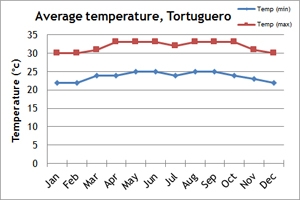
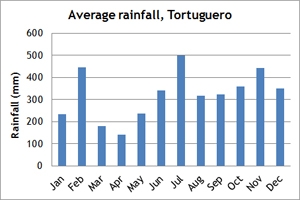
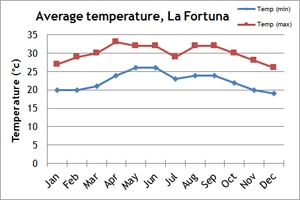
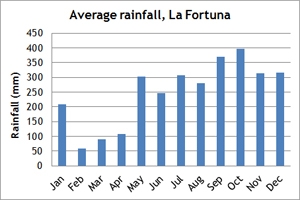
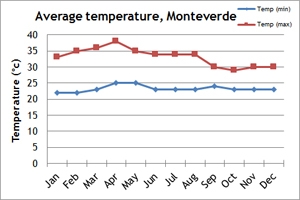
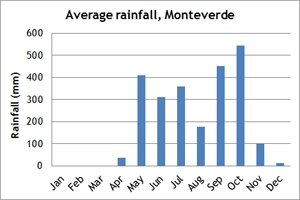
Costa Rica’s climate is dominated by its two seasons: the wet season (winter or the green season) which runs from May to November and the dry season (summer) which is mid-November to April. However, local micro-climates do introduce some unpredictability.
During the dry season most places see little rain and enjoy sunny days and warm temperatures whilst in the wet season you can expect considerable amounts of rainfall and a humid climate. During September and October the rains are at their heaviest and can prevent travel in some areas. We don’t recommend hiking in Costa Rica during these months.
Regional variations are particularly notable on the coasts with the south Pacific coast having a longer rainy season (December to February). The tropical Caribbean Coast with its extensive rainforest experiences the most rainfall of anywhere in the country with February and March relatively drier months, however you may experience a shower at any time of the year here. The cloudforest region around Monteverde can also attract rain at any time of the year.
As Costa Rica lies just north of the equator, temperatures are fairly consistent all year round. The main difference in temperatures occurs between the lowlands - the North, Guanacaste, the Pacific and the Caribbean, and the highlands including the Central Valley. Temperatures are on average 15 degrees cooler in the highlands.
The best time to embark on Costa Rica walking holidays or tours, is therefore considered to be during the dry season with December through March the peak months consequently prices are higher and accommodation more limited during these months.
Frequently asked Questions
- When is the best time to go walking in Costa Rica?
-
The best time for a walking holiday in Costa Rica is during the dry season which runs from early to mid-November through to the end of March. At this time of the year the days are hot, sunny and humid, and the trails are firm underfoot. However, even during these months you may experience some rain on the Caribbean coast and in the cloudforest region. It will also be cooler in the cloudforest as this is at a higher elevation.
- How much does it cost to hike in Costa Rica?
-
Hiking trails in Costa Rica do not have specific fees although national parks do charge an entry fee of around $15 in most cases. These fees are included in the cost of all of our Costa Rica walking holidays whether you book one of our small group departures or arrange a tailor made holiday. Our Costa Rica adventure holidays all include the services of an expert local guide, all transport, airport transfers, hotel accommodation, sightseeing and entry fees (as per the itinerary), and breakfasts, lunches and some evening meals.
- Is hiking in Costa Rica hard?
-
There are some tough hiking trails in Costa Rica but on our Gentle Walking & Wildlife holiday we stick to well-established, easy paths with very little in the way of ascent or descent. We include some of the best scenic trails such as the Rio Celeste trail, the walk around the base of Arenal Volcano and the thrilling walk between thermal features on the Las Pailas Trail in the Rincon de la Vieja National Park.
- Is it safe to hike in Costa Rica without a guide?
-
Costa Rica is a very safe country for tourists but, as with anywhere else, there are dangers in the wild if you stray far from the well-known trails on your own. We provide an expert local guide on all our Costa Rica walking holidays. Not only will they ensure that you stay safe on the trail, but they will also enhance your holiday with their in-depth knowledge of Costa Rica’s amazing flora and fauna, and their ability to spot wildlife that you would most likely miss without their well-trained eye.
- What should I pack for walking or trekking in Costa Rica?
-
A good, lightweight pair of walking shoes is advisable, particularly for walks in the cloudforest region where the trails can be wet and a slippy underfoot. For boat tours, town walks or beach strolls, walking sandals are just fine. As the weather will most likely be hot and humid keep clothing lightweight and breathable – t-shirts and shorts will help keep you cool or walking trousers/shirts made from lightweight materials if you prefer to cover up legs and arms. Wear a sunhat and use high-factor sunscreen and insect repellent. It’s also a good idea to carry a thin poncho in case of showers – this is better than a waterproof jacket which will quickly prove to be unpleasantly warm due to the high temperatures and humidity. If you book your Costa Rica hiking tour with us we will provide a detailed kit list when you book.
- What is the most difficult trek in Costa Rica?
-
Costa Rica is not particularly well-known for trekking trails as much of the country is covered in dense forest, with little infrastructure. Many areas are also protected from access and development in line with the country’s emphasis on environmental policies. There is however a new long-distance trekking trail being established – the Camino Trail – but that is still quite embryonic. In the meantime, most other trails are quite short and relatively easy, winding their way through the national parks and nature reserves, allowing you to focus on the wildlife and scenery. Our Gentle Walking & Wildlife Costa Rica holiday makes the most of these trails.





